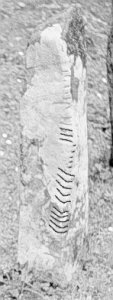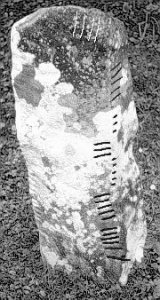Location and history:
According to BrOIM, 208, Pelham "appears to have discovered five of the inscribed stones" at the site which he "represents .. as a low Cairn flat on the top, the stones being in a circle". Human bones were found "on digging round their bases", as Hitchcock reported (in Ulster Journal Arch. V, I, 104; n.v.). The site was accordingly mentioned in Brash, JRSAI 16, 1884, 128 because of being a "pagan cemetery". Ferguson, however, stated that it could not be determined "whether the site was a cealluragh or a cemetery attached to a church" (OI, 42). Cill-vickillane means "The Graves of the Youths" according to Brash, OIM 208; but the Irish name given as Cill Mhic Uíleáin in DPAS, no. 792, p. 252 and OSDP, 7 speaks in favour of the former existence of a Christian cell (cf. the discussion about this in DPAS, 251).
The site was visited by Windele in 1838 who "found on the Cairn seven inscribed stones" (Brash, OIM) and made a "highly characteristic sketch" of the place (cf. Ferguson, OI 42 and DPAS, 251, according to whom it "shows the ogham stones set out in a rough semi-circle on top of the mound with a slab-lined grave positioned near-by".). By his second visit, in 1848, three of the stones {148, 149, 150} had been removed by Lord Ventry to his seat in Burnham, where they are still today, together with a fourth one {151} that had been stored in "Lough near Ballintaggart" until 1870 at least (cf. Ferguson, OI 43 and Brash, OIM 210, according to whom this was at "Lough House, within a quarter of a mile from Dingle, the residence of the Rev. Richard Chute) and with two stones from different localities [{147} and {175}]. Two other stones from Ballinrannig [{152}, {153}] were transferred to Chute Hall near Tralee, the (later) residence of Lord Ventry's son-in-law, Richard Chute. The seventh stone {154} remained on the site: "it was for long buried in sand" (so that it was not visible to Macalister when preparing Epig. 1: cf. p. 27), but was later "re-erected on a knoll, at or near the original site". - Brash visited Burnham in July 1868 (but not the original location in Ballinrannig, it seems).
Another "(fragmentary) stone" from the Ballinrannig site was recorded in Hitchcock's and Graves's notebooks; it was assigned {154A} in Macalister's CIIC.
The present stone ({148}) and nrs. {149}, {150}, and {151} have remained in the grounds of Lord Ventry's residence in Burnham until today (1998); the residence, however, has meanwhile become the site of a Girls' College (the Coláiste Íde) run by the Sisters of Mercy.
Size according to Brash, OIM 208 (no. 1): 3'10" above ground, x 13" x 8"
Size according to Macalister, CIIC: 3'5 1/2" x 1'10 1/2" x 0'8"
Size according to DPAS, no. 792 (2), p. 251: .99m x .33m x. .22m
- Published illustrations:
- Brash, OIM pl. XXVI, no. 1 (
 draft)
draft)- Macalister, CIIC I, 145 (
 draft).
draft). - Macalister, CIIC I, 145 (
Reading Brash, OIM 208:
Left angle:
ᚉᚐᚏᚏᚔᚉᚓᚄ
CARRICES
Right angle:
ᚋᚐᚊᚊᚔᚈᚓᚅᚐᚊ
MAQQITENAC
"CARRICES THE SON OF TENAC"
Reading Ferguson, OI 44 (64.):
MAQQITENAC
GILLAMURRas
Reading Macalister, Epig. 1, 27 (6.):
Left:
ᚉᚐᚏᚏᚔᚉᚐᚔ
CARRICAI
Right:
ᚋᚐᚊᚊᚔᚈᚓᚅᚐᚉᚒ..
MAQQITENACi
Reading Macalister, CIIC:
DUBONIRRAS MAQQI TENAC[I]
Interpretation Korolev, DP 76:
DUBONIRRAS/MAQQI TENACIἅ
Reading McManus, Guide 65:
DUBONIRRAS MAQQI TENACi
Reading DPAS, no. 792 (2), p. 251 (and OSDP, 8):
DUBONIRRAS MAQQI TENAC(I)
Reading Gippert (1978/1998):
 Dexter angle down (?) -
Dexter angle down (?) -  Sinister angle up:
Sinister angle up:(DUB)[A](N)IRR(A)[ ] || MAQQI TE(N)[A](C)[
(ᚇᚒᚁ)[ᚐ](ᚅ)ᚔᚏᚏ(ᚐ)[ ] || ᚋᚐᚊᚊᚔᚈᚓᚂ(ᚃ)[ᚐ](ᚉ)[
(ᚆᚆᚐᚐᚐᚁ)[ᚐ](ᚁᚁ)ᚁᚁᚁᚐᚐᚐᚐᚐᚋᚋᚋᚋᚋᚋᚋᚋᚋᚋ(ᚐ)[ ] || ᚋᚐᚆᚆᚆᚆᚆᚐᚐᚐᚐᚐᚆᚆᚆᚐᚐᚐᚐᚁᚁᚁᚁ(ᚁ)[ᚐ](ᚆᚆᚆᚆ)[
 Macalister's draft (in CIIC I, 145), the C (or Q?) of TENAC seems to be arranged at the top rather than the sinister angle. There is room for more than one vowel notch between N and C.)
Macalister's draft (in CIIC I, 145), the C (or Q?) of TENAC seems to be arranged at the top rather than the sinister angle. There is room for more than one vowel notch between N and C.)Additional literature:
Vallancey, Collectanea 6, 226: H. Pelham
Windele, MS 12 C 11;
Chatterton, Rambles (1839, 190).
Ulster Journ.Arch. V. I. p. 104: Hitchcock (acc. to Brash, OIM 208)